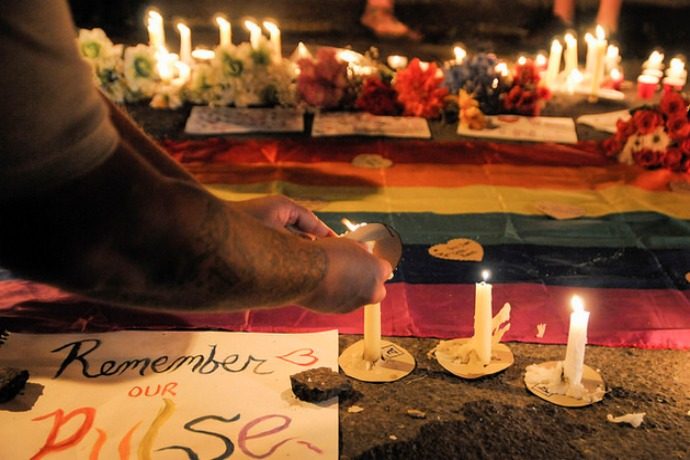Queer spaces are sanctuaries. Sanctuaries are spaces of safety and freedom. When violence enters a sanctuary, that is a violation of sacred space.
In the 1980s, as nearly a million Central Americans fled the violence of civil wars, some religious leaders defied the Reagan administration’s opposition to granting those refugees asylum. American money had paid for the guns that had killed many of these refugees’ family members, but American policy wanted them sent back to the violence.
The Sanctuary Movement defied the government by offering shelter to these refugees. From Medieval times, churches have provided shelter to the displaced and the homeless. This is a covenant: sacred space is safe space. Pastors, priests and rabbis who opened their churches to Central Americans did so at great risk: congregations sometimes turned against them, some were sent to jail, others shunned.
When Omar Mateen entered Pulse Nightclub armed with a legally purchased automatic weapon, he did so on Latin Night. As the names of the victims began to roll out, the list did not sound much different than the names of refugees who fled Central American violence in the ’80s: Fernandez, Menendez, Flores, Velasquez, Perez. A Puerto Rican drag queen had performed that night. In the photographs taken in daylight, the living clutching one another are mostly young and brown.
Are they refugees, the children of refugees, undocumented? Irrelevant. They are the living. Among the dead, a young man texting his mother: “Mommy I love you. He’s coming. I’m going to die.”
In the 1980s queers in San Francisco started to die. In the Castro, Most Holy Redeemer, one of the only Catholic churches in America to explicitly reach out to LGBTQ Catholics, became the site of near-daily funerals for AIDS victims. People gathered there to grieve, and the grief was nonstop. Fr. Anthony McGuire, pastor at the time, told Jesuit Fr. Donal Godfrey that “it was harrowing. I used to weep a lot at funerals. There was no break to it. It was one after another after another.”
Sanctuaries have a long history in the often bloody struggle for equality in the United States. Gay bars, lesbian bookstores, trans performance spaces, queer owned coffee houses, and yes, even churches, synagogues and mosques. These have been shelter, ritual, habit. But bars were the first sanctuaries for queers. Here under colored lights with the soundtrack that couldn’t be played at home, the garb of the outside world falls away. Here the true self can emerge, if only for a few hours, before the cops come in, the shooter, the good old boys with a confederate flag on their pickup, enraged bigots with hands full of flame.
In the ’80s I joined a band with a bunch of queers, all of them refugees from small towns. It was possible, in those days, to live in the Bay Area on the wages you made as a stripper, a cook, a house cleaner. It was possible to be two brown queers, a white queer, and a white straight girl and play improvised noise music in face paint and leggings in aluminum-walled clubs on the waterfront.
Later I joined another band led by a trans Nico impersonator and played cabaret nights at Klubstitute, where we were eighth or ninth in a lineup of drag spoken word, Riot Grrrrl bands waving dildos, “literati, glitterati, differently-gendered persons, as well as all manner of unaffiliated oddballs.” Just a few years earlier, I was a virginal Catholic school girl in a neatly pressed kilt. Queer space was sanctuary for friends and lovers; queer space was also a sanctuary for me.
I was their guest, my uncomfortable but flirt-worthy boyfriends were their guests, but this was the sanctuary we shared. And they became my family, and they became the people I trusted most, and some of them died, and some were beaten, and some wake up every day to a pile of pills that keeps them alive. Some were married, even in old age, after decades of loving; one friend wed his partner of four decades while he lay in their bed, dying of cancer. The home they’d bought was going to be their sanctuary in retirement. I wept often. I baked many cakes.
The young dead at Pulse will never be married now, will never roll over in the morning and see the face of a beloved, will never know that fights after decades together are about finding one another again and again, because love is a sanctuary.
Later I wandered back to religion, where gay priests heard my confessions, where I marched alongside lesbian Catholic sisters at protests, where queer Catholics read things I write and email asking for help finding the right kind of Catholic church, where the church I’d grown up in offered sanctuary to refugees but told its queer clergy to keep their mouths shut.
The Catholic church, however, is itself a kind of queer sanctuary. More than half of its priests are gay; they might tell you this over a glass of wine or in an email because you know what closeting did to your friends, or maybe you seem worthy of trust. This person playing the organ, that person catechizing the children, those people in the pews: this is a gay church as much as it insists on playing a straight one, as much as it tells its gay children they are “intrinsically disordered.” That same church lost Oscar Romero to a bullet in El Salvador, and took in Romero’s flock when they streamed North.
When violence enters a sanctuary, that is a violation of sacred space.
The phones of the dead at Pulse continued to ring for hours as those who loved them frantically dialed and re-dialed, hoping to find them alive. Violence tore open the sanctuary throughout history, tore it open over and over again. Violence brought queers into the streets of Orlando to hold one another and weep, brought queers into the streets to riot at Stonewall, brought people all over the world into the streets last night to grieve the cycle.
Now all space is queer space. Now all space is sacred.





